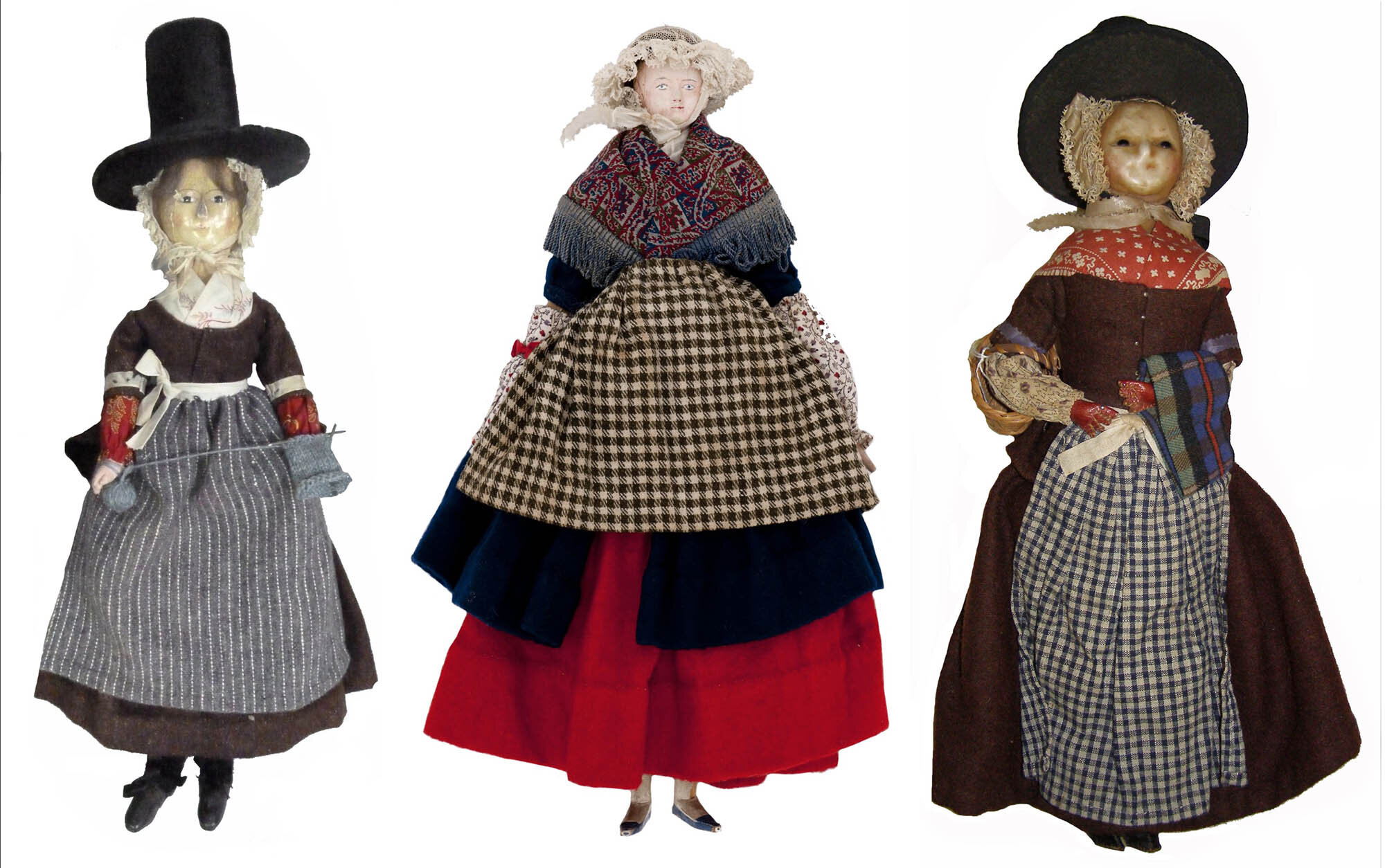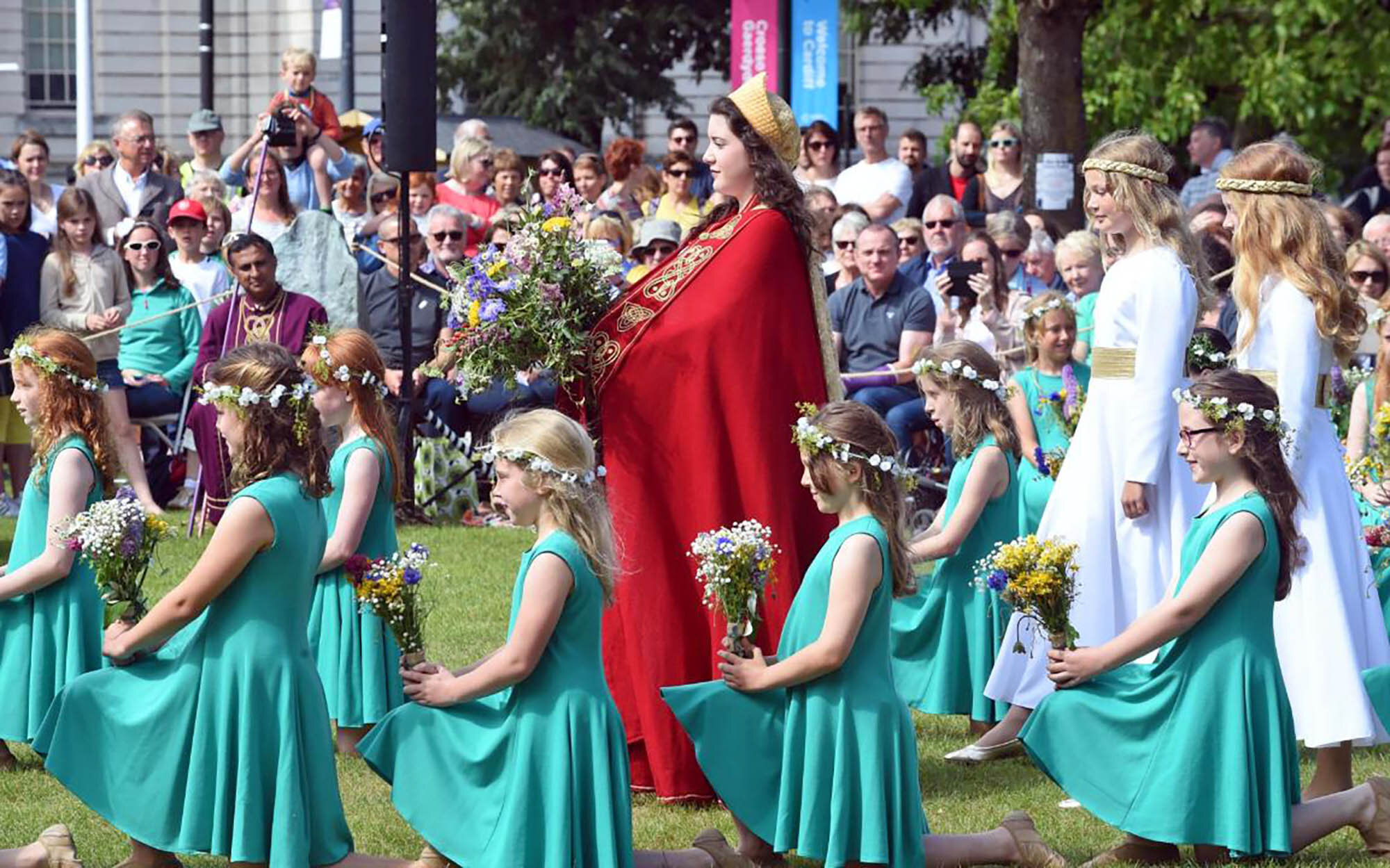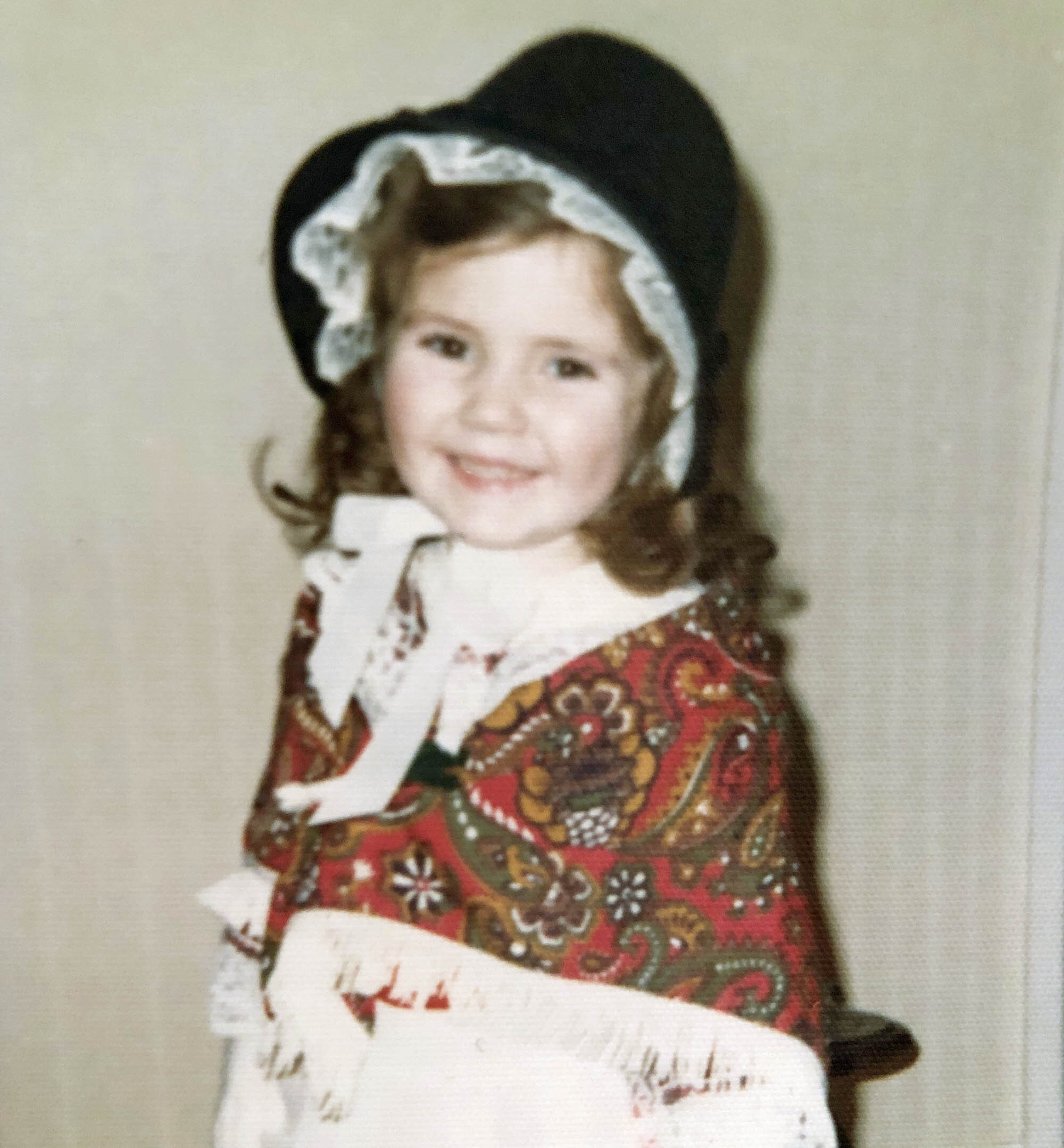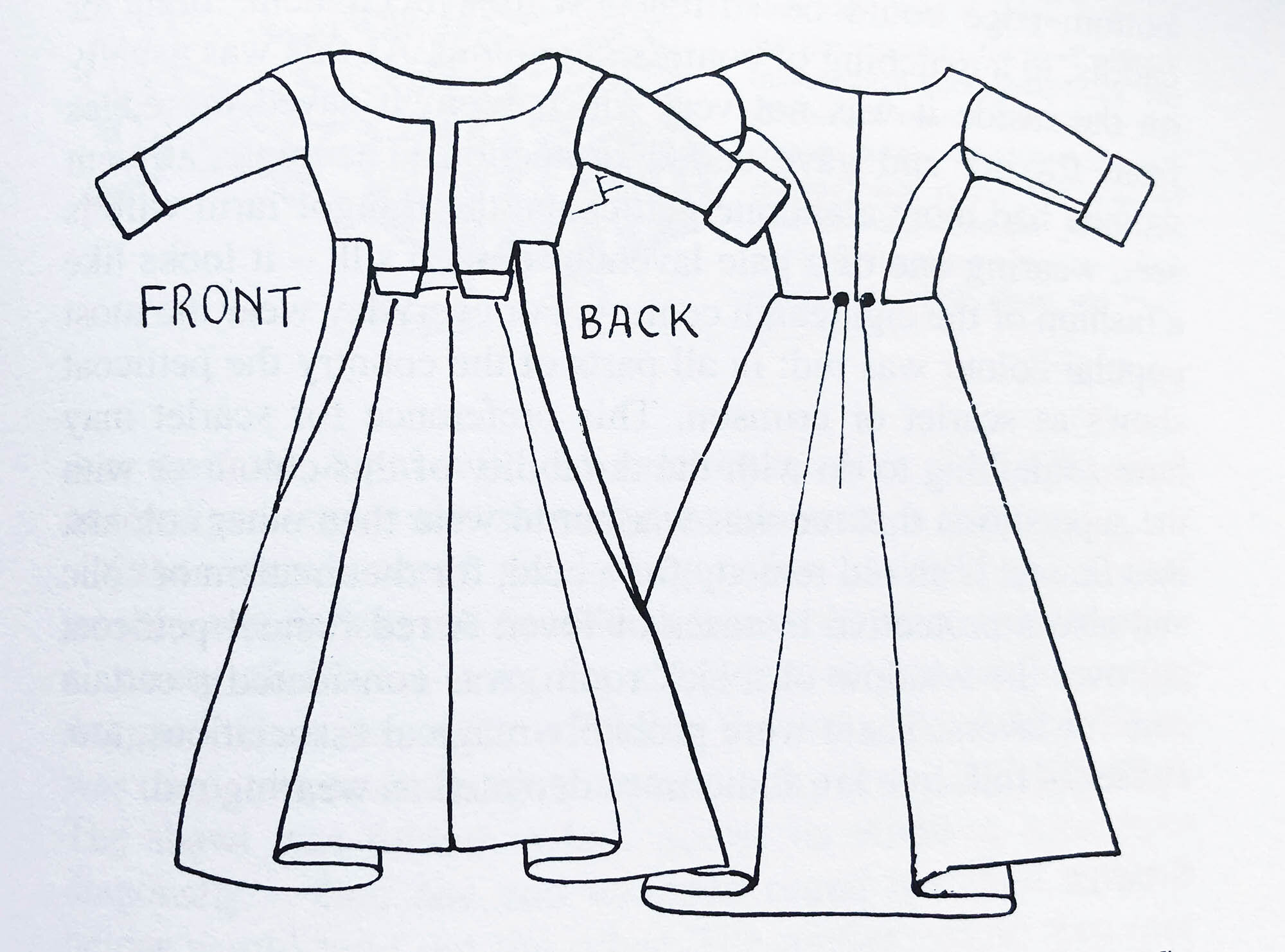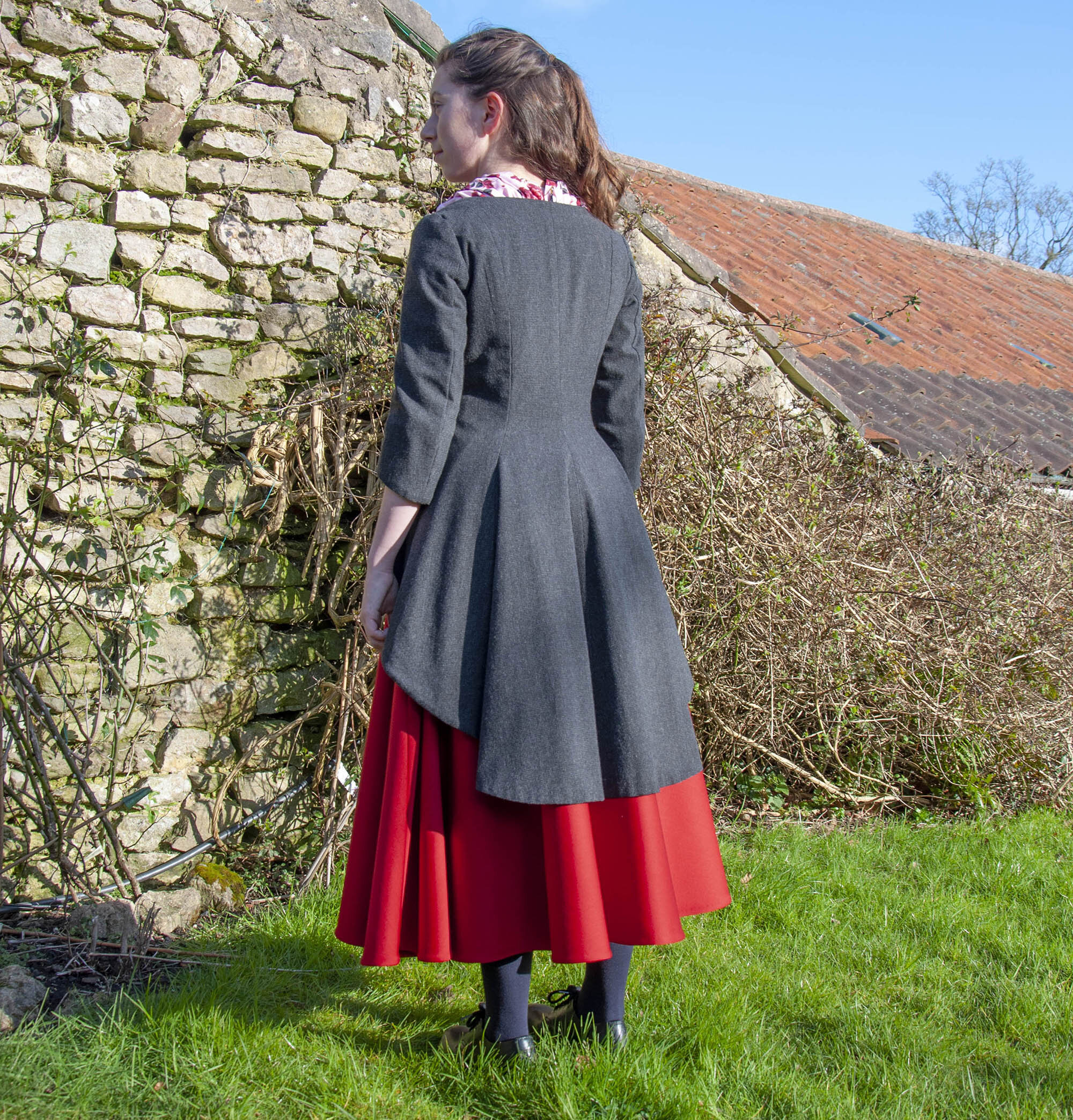A selection of antique dolls dressed in traditional Welsh costume (Left: Pembroke Museum. Centre: Amgueddfa Cymru/National Museum Wales. Right: Victoria and Albert Museum, Museum of Childhood)
Last September my teenage daughter (G) began to have Welsh clog-dancing lessons. She is enjoying it immensely and wants to represent her school by competing at the next eisteddfod. An ‘eisteddfod’ is a Welsh cultural festival where people can compete against one another through literature, music and performance. The tradition dates back to at least the 12th century. You can learn more here.
Proclamation of the 2018 National Eisteddfod in Cardiff (Daily Post).
In order to compete in an eisteddfod, G needs to have something suitable to wear. Most clog dancers wear clothes based on traditional Welsh dress, but since costumes like this are not readily available to buy for children over the age of about 10, the task to make something from scratch fell to me.
Me, aged about five. Schoolchildren in Wales wear traditional Welsh costume on St David’s Day, 1st March.
G wearing the same costume many years later.
The traditional costume for women that most people are familiar with is actually based on the every-day workwear which was worn in Wales during the eighteenth and nineteenth centuries. It consists of a long, gathered flannel skirt called a petticoat, a long (or short) skirted jacket with a fitted bodice called a ‘betgwn’ (bedgown), a full-length apron, a shawl or scarf, and the iconic, tall, black hat.
There were regional variations in style, and the flannel cloth which these garments were made from were often characteristically woven with stripes or small checks.
Nineteenth-century women wearing traditional Welsh dress (Narberth Museum).
The betgwn — a fitted bodice with full skirt (From ‘Welsh Costume’ by Ken Etheridge).
Original examples of the betgwn and petticoat (Left and centre: Ceredigion Museum. Right: Amgueddfa Cymru/National Museum Wales).
G and I watched lots of eisteddfod videos on YouTube to see how these traditional garments have been adapted for use by clog dancers today. The tall hat is not usually worn, and the apron appears to be optional, but apart from that, variations of the petticoat, betgwn and shawl are commonly worn.
We decided that for G’s costume we would omit an apron, although we may add one at a later date. We noted that the skirt needed to be very full as it is held out at the sides as an integral part of the dance. Traditionally the skirt is gathered to create the fullness, but in the videos we watched, we noticed that some dancers wore a style based on a circle-skirt. This allows for plenty of width but without the bulk at the waist. It also creates a very pleasing flat front when held out at the sides.
For the betgwn, G really liked the idea of a three-quarter length style, cut away at the sides and curving down to the back.
An historical example of a shorter betgwn with the curved, cutaway sides which G was keen on (Ceredigion Museum).
We decided against a shawl in favour of a ‘tucked-in scarf’ idea that we’d seen in some historical examples during our research. It seemed neater than a cumbersome shawl and seemed to be an opportunity to include a pretty print.
A tucked-in neck scarf as shown in this watercolour illustration from ‘Welsh Costume and Customs: The National Library of Wales Picture Book No 1’.
I searched really hard but couldn’t find any commercial sewing patterns for traditional Welsh dress. This must be a gap in the market when you consider the number of people competing in the eisteddfods each year. If you’re a sewing pattern designer, consider this to add to your portfolio — you’ll make a fortune!
So I had to get creative, and source other patterns which could be adapted to suit the ideas we had. I settled on a historical pattern from McCall’s for the betgwn (M7916), and a pattern from New Look (6580) for the skirt.
The two commercial sewing patterns I bought on which to base the costume.
G chose the main fabric (fine wool suiting) from a selection of samples I ordered from Fabworks. Our budget wouldn’t run to authentic cloth from a Welsh woollen mill for this experimental project, but maybe next time now that I know what I’m doing and won’t be as nervous. She settled on a beautiful red wool with a sateen finish for the skirt as it had a lovely weight and draped beautifully. She then chose a contrasting charcoal grey wool (with a tiny black check) for the betgwn. For the neck scarf she chose a crisp cotton print from my fabric stash called ‘Social Climber’, in red and pink, by Anna Maria Horner.
G’s fabric choices.
I made the skirt first, which sewed up incredibly quickly. There were only three pattern pieces (including the waistband). As hoped, the pattern provided plenty of width for the skirt and is perfect for twirling and swishing — essential characteristics for a clog-dancing skirt!
The betgwn proved to be more of a head-scratcher. The McCall’s pattern provided vaguely the correct overall shape, but it was too full, too structured, and too formal for what we needed. The pattern relied on separate inset pleats around the skirt to give extra fullness — which we didn’t need.
The McCall’s commercial pattern I hacked for the betgwn.
Using the original pattern pieces as a template, I re-drew it for a practice toile and left out the separate pleat pieces. I smoothed out the waist to allow for this omission, and then cut away the front openings into a dramatic curve from front waist to back hem.
One of the pattern pieces I redrew, with a smoothed out waist and cutaway sides.
The first toile was (incredibly) almost perfect with just a few alterations needed to the waist area. I made a second toile to be sure, then took a deep breath and cut into the wool cloth.
First toile of the betgwn.
The jacket sewed together fairly easily, and is fully lined. The front fastens with hook and bar closures. By leaving out the pleats, the betgwn drapes beautifully at the back, echoing the soft folds of the skirt.
Back view of the finished betgwn and skirt.
I measured across G’s shoulders from the front to the back of the bodice, to create a pattern for the gathered ‘neck scarf’. I attached the scarf to the betgwn with pop-fasteners so that it will be easy to swap out for a different one if G gets tired of it.
The neck scarf is attached to the betgwn bodice with pop fasteners.
I am so pleased with the way this pattern hack has worked out. I’ll consider making another skirt and neck scarf, in different colours, for a completely new look in the future.
The completed costume.
The video below shows G practicing her clog dancing in her new costume.
Please leave a comment below, especially if you’ve ever tried to make a historical costume. I’d love to hear about your experience.

